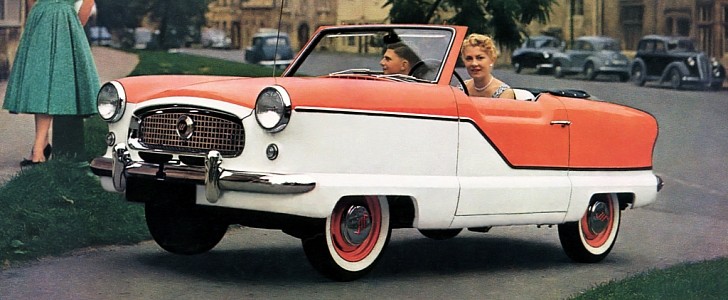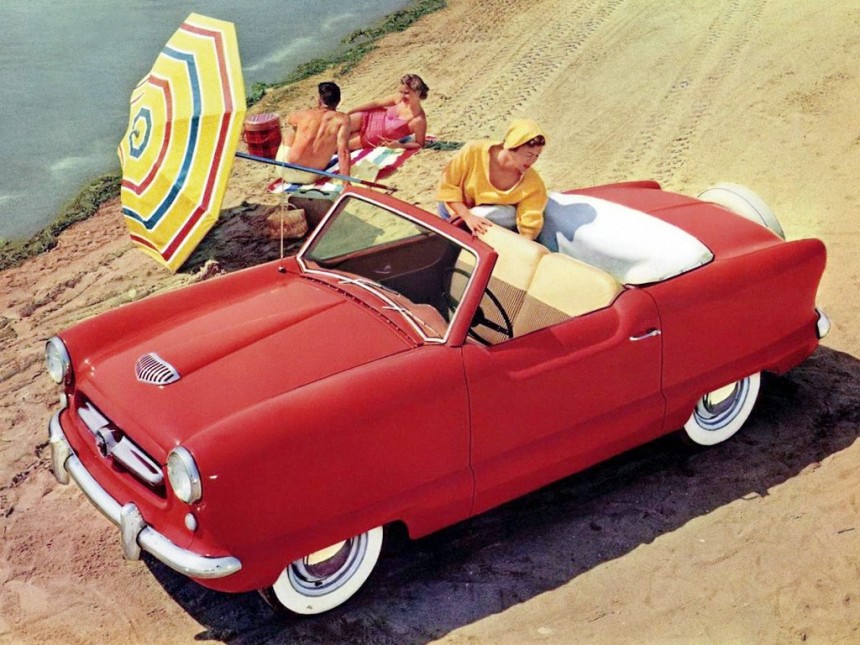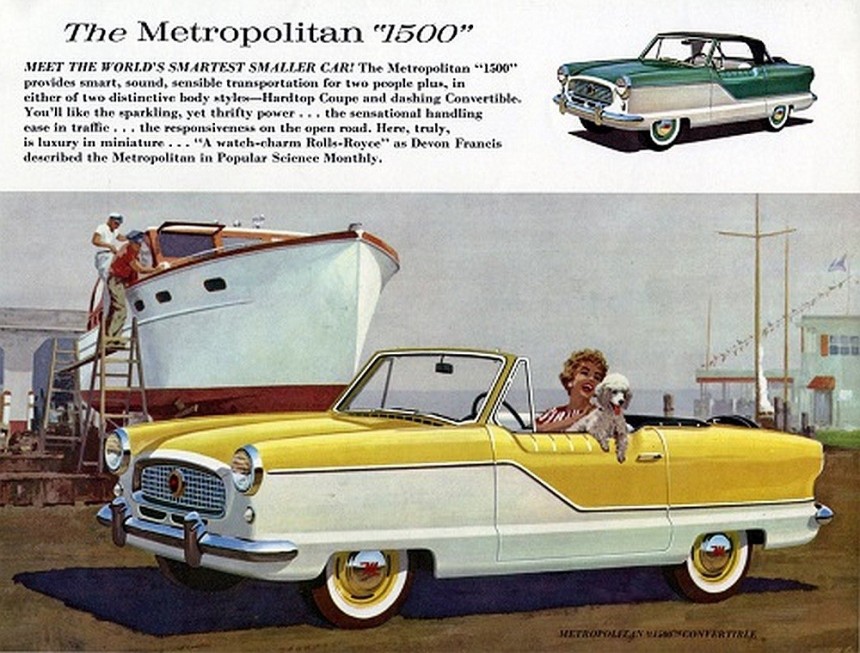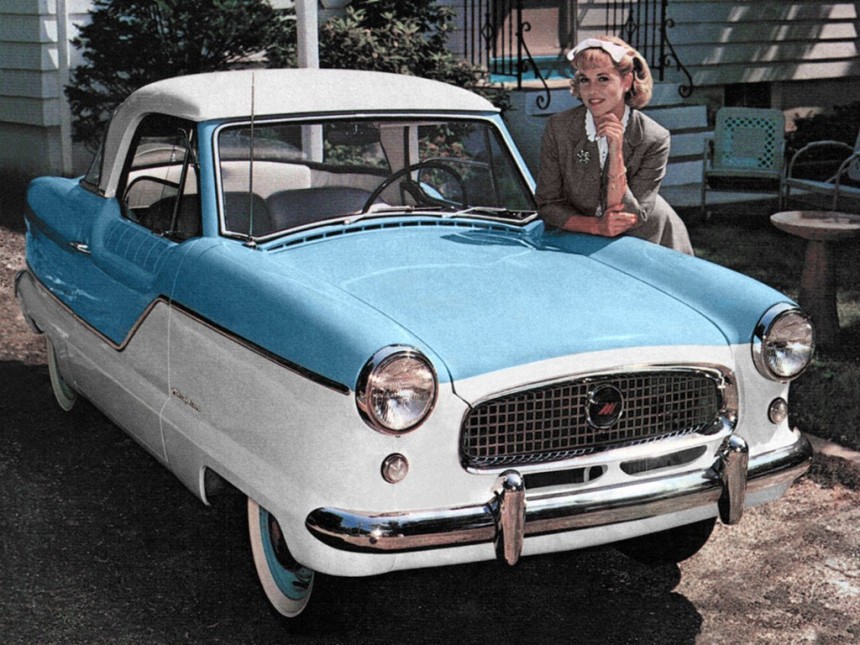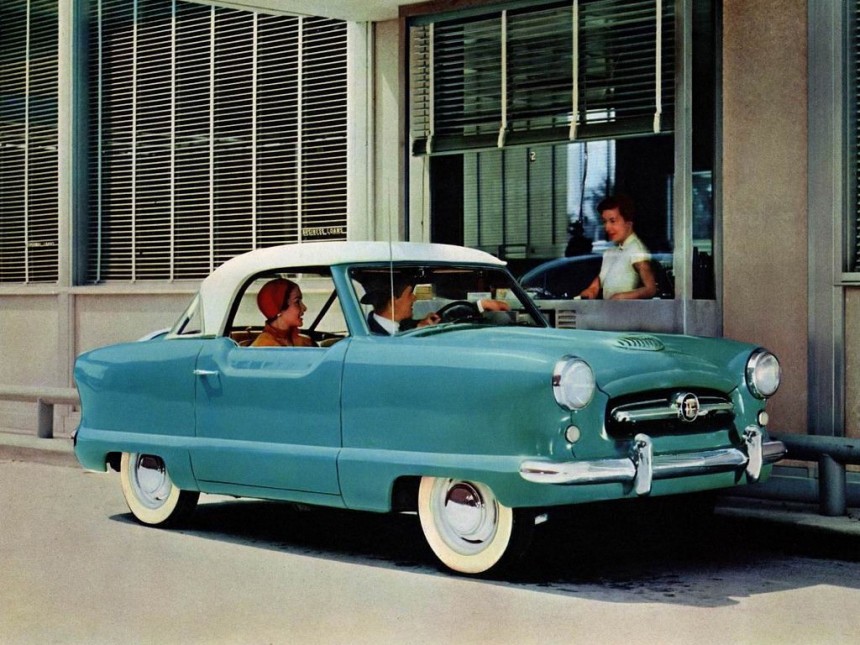The 1950s and 1960s are regarded as the golden decades of the American automobile. The cars became bigger and more luxurious and engines became larger and more powerful. But while the Big Three were following the "bigger is better" philosophy, Nash Motor Company decided that America needed an economical transportation alternative. And the Metropolitan was born.
Established in 1918, Nash was one of the very few independent carmakers that survived the Great Depression. In 1949, it introduced the innovative Airflyte, which spawned the Ambassador luxury full-size. It was followed by the introduction of the Rambler, the first post-WW2 compact, and the Nash-Healey sports car in 1950 and 1951, respectively.
But Nash didn't stop there. As vehicles from the Big Three were becoming bigger and more powerful, company executives began working on a car smaller than the Rambler that would compete with the likes of the Volkswagen Beetle.
The project led to a manufacturing collaboration with U.K.'s Austin and the birth of the Metropolitan. Launched in 1953, a year before Nash and Hudson merged to create American Motors Corporation (AMC), the Metropolitan became America's first subcompact car.
Designed in the United States and assembled in England, the Metropolitan was a rather quirky idea for the American marketplace. While it resembled the "bathtub" design of the massive Ambassador, it had a significantly smaller footprint at only 149.5 inches (3,797 mm) long.
The Metropolitan was actually a full 11 inches (279 mm) shorter than a Volkswagen Beetle, which was unheard of for an American vehicle at the time.
But unlike the latter, the tiny Nash used a conventional layout with a front-mounted engine that powered the rear wheels. On the other hand, Nash opted for a unibody design, which was still new at the time, when most manufacturers were still using a body-on-frame construction.
Under the shell, the Metropolitan was pretty much an Austin, as the British firm supplied both the suspension and the drivetrain. So while most Nash production cars came with inline-six engines, the Metropolitan relied on a British-built four-cylinder.
The subcompact debuted with a BMC B-series 1.2-liter mill. Shared with the Morris Cowley and Austin A40, it delivered only 39 horsepower. Although it may seem laughable even for mid-1950s standards, it was enough to push the 1,800-pound (816-kg) Nash to a top speed of around 70 mph (113 kph).
The Metropolitan charged from 0 to 60 mph in 22.4 seconds. Painfully slow, yes, but still notably quicker than the Beetle.
In 1955, Nash upgraded the Metropolitan to a 1.5-liter four-pot. Good for a more appealing 55 horsepower, it enabled the two-door to hit a top speed of more than 80 mph (129 kph). Both mills allowed the Metro to run on low-quality gasoline and mated to three-speed manual gearboxes with the shifter mounted on the steering column.
But while it was far from fast, the Metropolitan returned tremendous fuel economy. Long-term tests of the era revealed a mileage of almost 40 mpg at 45 mph (72 kph) and 30 mpg in city traffic.
An official 24-hour, non-stop mileage test, saw the Metropolitan return 41.57 mpg at an average speed of almost 35 mph (56 kph).
Nash offered both coupe and convertible versions of the Metropolitan, all available in a variety of two-tone paint schemes. Impressively enough, the subcompact also came with standard features that were optional on most vehicles of the era. The list included electric windshield wipers, interior lighting, a Continental tire kit, AM radio, and a cigarette lighter.
Although it never reached the popularity of Detroit-made compact cars, the Metropolitan remained in production for almost 10 years, with the final car assembled in 1962.
The Metropolitan was also sold as a Hudson and, after AMC dropped both the Nash and Hudson company names in 1957, it was marketed as a stand-alone brand and sold through Rambler dealers.
After a few successful years with more than 10,000 units per year delivered, the Metropolitan became a slow seller in the early 1960s, faced with competition from then-new compact cars from the Big Three.
The fact that AMC's very own Rambler American, which offered seating for five people, was only $100 more expensive also led to the Metro's demise.
American Motors pulled the plug on subcompact in 1962, after almost 95,000 units sold in the United States and Canada.
One of the very few cars that swam against the "bigger is better" trend of the 1950s, the Metropolitan enjoys a cult following.
Some think it's a cute car, while others find it downright ugly to look at. But most agree that the Metropolitan was ahead of its time and performed well against subcompact imports.
Some 60 years later and these once-affordable "mini tubs on wheels" can fetch more than $35,000 in Concours-ready condition.
But Nash didn't stop there. As vehicles from the Big Three were becoming bigger and more powerful, company executives began working on a car smaller than the Rambler that would compete with the likes of the Volkswagen Beetle.
The project led to a manufacturing collaboration with U.K.'s Austin and the birth of the Metropolitan. Launched in 1953, a year before Nash and Hudson merged to create American Motors Corporation (AMC), the Metropolitan became America's first subcompact car.
Designed in the United States and assembled in England, the Metropolitan was a rather quirky idea for the American marketplace. While it resembled the "bathtub" design of the massive Ambassador, it had a significantly smaller footprint at only 149.5 inches (3,797 mm) long.
But unlike the latter, the tiny Nash used a conventional layout with a front-mounted engine that powered the rear wheels. On the other hand, Nash opted for a unibody design, which was still new at the time, when most manufacturers were still using a body-on-frame construction.
Under the shell, the Metropolitan was pretty much an Austin, as the British firm supplied both the suspension and the drivetrain. So while most Nash production cars came with inline-six engines, the Metropolitan relied on a British-built four-cylinder.
The subcompact debuted with a BMC B-series 1.2-liter mill. Shared with the Morris Cowley and Austin A40, it delivered only 39 horsepower. Although it may seem laughable even for mid-1950s standards, it was enough to push the 1,800-pound (816-kg) Nash to a top speed of around 70 mph (113 kph).
In 1955, Nash upgraded the Metropolitan to a 1.5-liter four-pot. Good for a more appealing 55 horsepower, it enabled the two-door to hit a top speed of more than 80 mph (129 kph). Both mills allowed the Metro to run on low-quality gasoline and mated to three-speed manual gearboxes with the shifter mounted on the steering column.
But while it was far from fast, the Metropolitan returned tremendous fuel economy. Long-term tests of the era revealed a mileage of almost 40 mpg at 45 mph (72 kph) and 30 mpg in city traffic.
An official 24-hour, non-stop mileage test, saw the Metropolitan return 41.57 mpg at an average speed of almost 35 mph (56 kph).
Although it never reached the popularity of Detroit-made compact cars, the Metropolitan remained in production for almost 10 years, with the final car assembled in 1962.
The Metropolitan was also sold as a Hudson and, after AMC dropped both the Nash and Hudson company names in 1957, it was marketed as a stand-alone brand and sold through Rambler dealers.
After a few successful years with more than 10,000 units per year delivered, the Metropolitan became a slow seller in the early 1960s, faced with competition from then-new compact cars from the Big Three.
American Motors pulled the plug on subcompact in 1962, after almost 95,000 units sold in the United States and Canada.
One of the very few cars that swam against the "bigger is better" trend of the 1950s, the Metropolitan enjoys a cult following.
Some think it's a cute car, while others find it downright ugly to look at. But most agree that the Metropolitan was ahead of its time and performed well against subcompact imports.
Some 60 years later and these once-affordable "mini tubs on wheels" can fetch more than $35,000 in Concours-ready condition.
